Dussehra Festival
The festival that signifies the triumph of good over evil, Dussehra, is one of the most noteworthy Indian festivals. It is observed on the tenth day of Navaratri. This festival is celebrated to commemorate the victory of Lord Rama over the demon Ravana. This holy festival is the occasion to hold in the highest regards, the virtues of Lord Rama, who is believed to be an incarnation of Lord Vishnu (The ‘Presever’ god in Hindu Trinity). Dussehra strengthens the vows of devotees to follow the path and deeds of Lord Rama.
LEGENDBEHIND DUSSEHRA FESTIVAL
The festival that signifies the triumph of good over evil, Dussehra, is one of the most noteworthy Indian festivals. It is observed on the tenth day of Navaratri. This festival is celebrated to commemorate the victory of Lord Rama over the demon Ravana. This holy festival is the occasion to hold in the highest regards, the virtues of Lord Rama, who is believed to be an incarnation of Lord Vishnu (The ‘Presever’ god in Hindu Trinity). Dussehra strengthens the vows of devotees to follow the path and deeds of Lord Rama.
LEGENDBEHIND DUSSEHRA FESTIVAL
The pious Hindu epic Ramayana unfolds the legendary tale of Lord Rama winning his beloved wife Sita, who was abducted by demon Ravana, the emperor of Lanka.
According to Hindu mythology, Shoorpnakha, the sister of Ravana, fell in love with Rama and Lakshmana (Rama’s younger brother), and wanted to marry any one of them. After being refused by both, she threatened them to kill Sita. Lakshamana, in anger, cut her ears and nose. This lead to Ravana abducting Sita in order to take revenge of her sister. To rescue Sita, Rama and Lakshmana fought a battle with Ravana in Lanka. Lord Hanuman and an enormous army of monkeys helped the brothers.
There is also a reference associated with the celebration of Dussehra festival in the great epic Mahabharata. With different unique weapons, Pandavas fought with several evil forces. These five brothers abandoned their weaponries and left into one-year exile. After returning from exile, they found their weapons under the Shami Tree under which they had buried them before going off for exile. Pandavas worshipped the tree before their battle in which they emerged victorious. This legend is also memorialized at the time of Dussehra Festival.
The festival of Dussehra is celebrated on the 10th day or Vijay Dashmi. It is believed that Lord Rama worshipped Goddess Durga before going to war against Ravana on the advice of Lord Vishnu.Rama won the war convincingly and hence the festival is celebrated on the next day of Rama Navami.
The word Dussehra is derived from two Sanskrit words - 'dasha' that represents the ten heads of Ravana, and 'hara', which translates to 'defeat'. In the eastern part of India and in the Bengali culture, Vijay Dashmi celebrates the victory of Goddess Durga over 'buffalo demon' Mahishasura whose demonic activities had disrupted the daily livelihoods of many on Earth.
Celebrations of Dussehra in India
Dussehra is celebrated in a distinct way with great fervor across the nation. The different methods of celebrating this festival in different regions are:
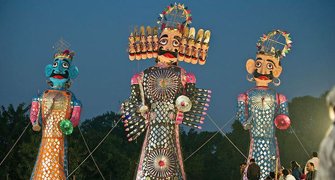
Celebrating Dussehra in North India
Dussehra is normally celebrated by flaming the effigies of Ravana, Meghanatha and Kumbhakarna. With this burning, the play Ramleela, displaying the story of Ramayana, also comes to an end. Generally, a fete is also organized for the people. Three individuals enacting Rama, Lakshamana and Sita sitting on a chariot, pass through the crowd. The artist performing Rama’s role aims the arrow in order to burn all the three effigies separately.
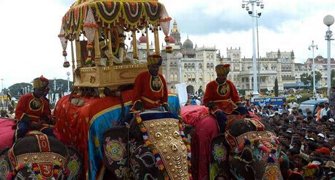
Celebrating Dussehra in South India
Dussehra is celebrated in a distinctive manner in the Southern part of India. On this festive day, toys and dolls are decorated in all the houses. This ritual had commenced from the abode of emperors in erstwhile era. This day is popular as Gombe Habba in South India. In olden times, Dussehra was limited to the well-off people. However, it gained regard with time and reached to the common people as well.
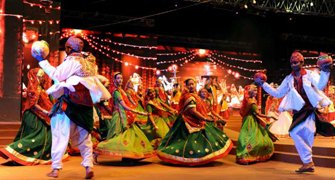
Celebrating Dussehra in Gujarat
The people of Gujarat assemble and dance on each night during Navaratri. Several competitions are held on the Dussehra festival and men and women perform a unique Gujarati dance ‘Garba’ on devotional songs. This dance continues till late night. In various places, this dance continues even till the break of dawn. Women put on their best clothes and decorate earthen pots wonderfully.
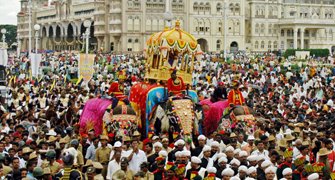
Celebrating Dussehra in Mysore
In Mysore, several fairs and cultural performances are organized. The grand parade of bedecked elephants and guards sitting on a horseback, escort the idol of Goddess through the city. This parade is the major highlight of the ten-day celebration of Dussehra in Mysore.
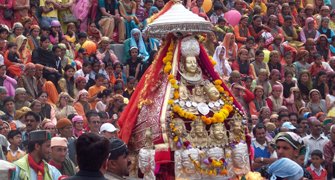
Celebrating Dussehra in Kullu
In Kullu, chariots are decorated with amazing hues. Goddess deities are taken around on these beautiful chariots and people dance with joy and elation to rejoice the festive day of Dussehra.

إرسال تعليق
If you have any doubts, please let me know